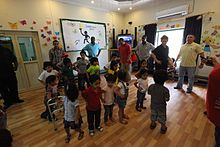
Back تعميم (تعليم) Arabic Schulische Integration German Inclusion scolaire French שילוב בחינוך HE 統合教育 Japanese Мэйнстриминг (образование) Russian Kaynaştırma (eğitim) Turkish 融合教育 Chinese
| Disability |
|---|
|
|

Mainstreaming, in the context of education, is the practice of placing students with special education needs in a general education classroom during specific time periods based on their skills.[1] This means students who are a part of the special education classroom will join the regular education classroom at certain times which are fitting for the special education student. These students may attend art or physical education in the regular education classrooms. Sometimes these students will attend math and science in a separate classroom, but attend English in a general education classroom. Schools that practice mainstreaming believe that students with special needs who cannot function in a general education classroom to a certain extent belong in the special education environment.[2]
Access to a special education classroom, are mostly called a "separate classroom or resource room", is valuable to the student with a disability. Students have the ability to work one-to-one with special education teachers, addressing any need for remediation during the school day. Many researchers, educators and parents have advocated the importance of these classrooms amongst political environments that favor their elimination.[3]
Oftentimes mainstreamed students will have certain supports they will bring to the general education classroom. A common support is to bring a one-on-one aide to assist them. Other equipment may be tools from their special education classroom that assist them in keeping up with the demands of the general education classroom. This may be a device that helps a deaf student communicate with their peers, a special chair for a student diagnosed with Down syndrome, or a special desk for a student that is in a wheelchair. Some of these students may need accommodations on assignments or tests.[4]
Proponents of both the philosophy of educational inclusion assert that educating children with disabilities alongside their non-disabled peers fosters understanding and tolerance, better preparing students of all abilities to function in the world beyond school.[5] Children with special needs may face social stigma as a result of being mainstreamed, but also may help them socially develop.[6]
There is often a lot of confusion between the terms mainstreaming and inclusion. Often these terms are used interchangeably, but they mean two very different things. Mainstreamed students are part of the special education classroom. When they enter the regular education classroom for certain subjects, this is considered mainstreaming. In comparison, inclusion students are regular education classroom students who receive special education services. Usually whether is not a student's education is mainstreamed or inclusion is based on which is the least restrictive environment, which can be determined in the student's IEP.[7] Dr. Kenneth Shore comments on the least restrictive environment by claiming, "Determining what is the least restrictive environment for a particular student requires balancing the need for the child to learn to integrate socially with his non-disabled peers with the need for the child to receive instruction appropriate to his abilities."[8]
- ^ [1] Definition of mainstreaming, accessed October 11, 2007. Archived 2009-11-01.
- ^ "Special Education Inclusion". Archived from the original on 2007-10-14. Retrieved 2007-10-14. Mainstreaming: "Special needs students "belong" in the special classroom", accessed October 16, 2007
- ^ Sindelar, Paul T.; Deno, Stanley L. (January 1978). "The Effectiveness of Resource Programming". The Journal of Special Education. 12 (1): 17–28. doi:10.1177/002246697801200105. S2CID 145561230.
- ^ "Talking To Kids: Mainstreaming Into Classrooms". www.bridges4kids.org. Retrieved 2018-12-09.
- ^ IDEA Funding Coalition, "IDEA Funding: Time for a New Approach," Mandatory Funding Proposal, Feb. 20 2001, p. 2.
- ^ Carissa Lawrence. "Advantages & Disadvantages to Mainstreaming Special Education Children". The Classroom.com.
- ^ "Inclusion vs. Mainstreaming: What You Need to Know Before Putting Your Child in a Classroom Program". The Edvocate. 2016-11-04. Retrieved 2018-12-09.
- ^ "Mainstreaming Special Education Students: The Parent Role". Dr. Kenneth Shore. Retrieved 2018-12-09.
© MMXXIII Rich X Search. We shall prevail. All rights reserved. Rich X Search